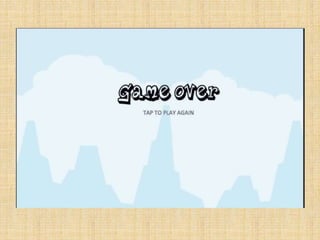Game engineering_Tappy plane - jiit13-14
- 1. GAME ENGINEERING DEPARTMENT OF COMPUTER SCIENCE ENGINEERING AND INFORMATION TEHCNOLOGY JAYPEE INSTITUTE OF INFORMATION TECHNOLOGY, NOIDA SUPERVISOR : Mr. Prashant Kaushik Project Members : Sidharth Sharma [10103406] Nikhil Ansal [10103429]
- 2. INTRODUCTION Computer and Video Games are one of the most popular and the most important products of the software industry. One of the greatest contributors to this success is the rapid improvement of technologies. However, the Game Development processes still have to face some difficulties. In fact, the lack of guidelines and theoretical foundations are the major causes for most of Game Designers need to bring their own experiences and intuitions into the Game Design. Therefore, it is essential to increase the involvement of the Human Computer Interaction (HCI) and design in the processes of designing games.
- 3. OBJECTIVE To Develop a Flappy birds type side scrolling game from scratch which aims at providing an enjoyable environment and to learn as to how HCI principles help in making even a very basic game successful. Thus we have made an attempt to understand the role of HCI in User Experience and Game Design and to make a well accepted game.
- 4. Problem Statement Design physics based 2D platform game, incorporating the physics system of Game Engine to govern the environmental objects and player character. The game aims at providing enjoyment and increase learning of the users regarding various fundamental concepts of physics such as friction, velocity, bounciness and collisions. It¡¯s aim is also to study HCI principles and their role in User Experience and Game Designing.
- 5. WHAT IS A SIDE SCROLLING GAME ? A side-scrolling game or side-scroller is a video game in which the gameplay action is viewed from a side-view camera angle, and the onscreen characters generally move from the left side of the screen to the right (or less commonly, right to left) to meet an objective. These games make use of scrolling computer display technology. The move from single-screen or flip- screen graphics to scrolling graphics, during the golden age of video arcade games and during third-generation consoles, would prove to be a pivotal leap in game design, comparable to the move to 3D graphics during the fifth generation.
- 6. PROPOSED ALGORITHM ? Integrated physics engine and a set of 2D physics components ? Rigid-body component (RigidBody2D) supporting static/kinematic/dynamic body, mass, linear/angular velocities, drag and auto-sleeping and fixed-angle constraint. ? Circle collider (CircleCollider2D) supporting a centroid and radius. ? Rectangle collider (BoxCollider2D) supporting a centroid and a size.
- 7. TECHNOLOGY USED ? Language : C# in Monodevelop, Behaviourial settings and XML ? Software Platform : Unity3D
- 8. TEST PLAN The purpose of testing is quality assurance, verification and validation, or reliability estimation. ? Functionality Testing ? Compatibility testing ? Beta testing ? Soak Testing ? Regression Testing
- 9. SCREENSHOTS
- 12. THANK YOU Group Members : Sidharth Sharma [10103406] Nikhil Ansal [10103429]

![GAME ENGINEERING
DEPARTMENT OF COMPUTER SCIENCE ENGINEERING
AND INFORMATION TEHCNOLOGY
JAYPEE INSTITUTE OF INFORMATION TECHNOLOGY,
NOIDA
SUPERVISOR : Mr. Prashant Kaushik
Project Members :
Sidharth Sharma [10103406]
Nikhil Ansal [10103429]](https://image.slidesharecdn.com/gameengineering-tappyplane-jiit13-14-140529080149-phpapp01/85/Game-engineering_Tappy-plane-jiit13-14-1-320.jpg)










![THANK YOU
Group Members :
Sidharth Sharma [10103406]
Nikhil Ansal [10103429]](https://image.slidesharecdn.com/gameengineering-tappyplane-jiit13-14-140529080149-phpapp01/85/Game-engineering_Tappy-plane-jiit13-14-12-320.jpg)